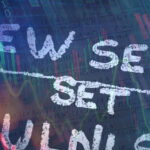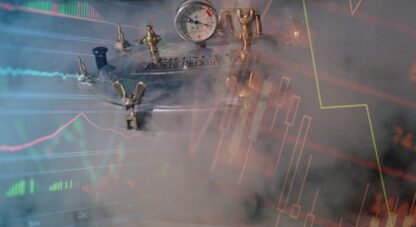The Bullard Put?
This was a very special week for the McAlvany Financial Group as we marked the milestone of a remarkable 50 years of business. Fifty years ago, the McAlvany’s found an innovative way to legally circumvent the laws of the day and enter the gold business. In the years that followed, they built a business and helped open the door to overturning those very same laws. The company is still family owned and operated, and, at present, reflects both the experience of five decades of expertise and the youth and energy of a new generation engaged in solving today’s financial market problems. With the founders in town, we took time on Friday to celebrate with BBQ and beer. Thanks go out to the McAlvanys, as well as to all those we have the privilege to serve.
In contrast to the beauty of celebration and the Colorado Rocky Mountain springtime, however, this week was a notably ugly one for financial markets. A bear market benchmark was briefly reached in the S&P 500, credit markets broadcasted ramping stress, evidence of a deteriorating consumer mounted further, and the corporate retail economy formally announced disarray.
Risk was decidedly off. Equities were lower, led by all-things consumer, as both the consumer discretionary and staples sectors were mercilessly punished. Safe-haven bonds rallied, yields dropped, and the 5-yr vs. 10-yr yield curve re-inverted, offering the bond market’s latest hint of a possible incoming recession. Commodities were generally higher, the precious metals complex rallied, and potentially significant reversals occurred in the currency markets.
The increasing credit stress was most clearly evidenced by notable across-the-board increases in credit default swaps, widening credit spreads, and particularly with a significant decline in the high-yield “junk” market. The developments all point to significant de-risking and deleveraging among the professional class, and the effect is exacerbating a pre-existing market illiquidity problem.
Outside of developments in credit, currencies, and the latest Fedspeak, the main events of the week came courtesy of earnings reports from major retailers. In bear markets, surprises come on the downside. After an early week rally, the mood on Wall Street turned decidedly disgusted after bad earnings reports from major retailers instigated broad-based selling. As inflation soars, costs bloat, and consumer buying preferences shift, retailer margins and earnings are now reflecting the hit. Worse, this is likely just the beginning of the downturn in margins and earnings.
In addition, prices for essentials such as food and gas continue to climb. Just this week, nationwide average gas prices hit a new all-time high, and JPMorgan warned that gas prices could increase another 35%–40% by August. As such, the market is beginning to anticipate that consumer spending will increasingly flow towards the essentials, leaving a smaller slice of the pie for the remainder of the economy.
This week, an IBD/TIPP Poll found that only 18% of the adults surveyed say their earnings have kept pace with inflation. In addition, the stretched and stressed consumer is being reflected in recent consumer credit card data that is now surging. The consumer credit data suggests that consumers have turned from now spent savings to credit borrowing in a big way to facilitate spending. This is unsustainable. A limit will be reached, at which point belt tightening will be the only option.
Reflecting market recognition of all these facts, major retailers Target, Walmart, and Ross Stores were trashed in the wake of their weak reports. On Friday, Deere poured fuel on the fire. The farming equipment company reported that the surge in fuel costs on farms is discouraging customer spending on new equipment.
This week’s earnings revelations likely accelerated a widespread awakening to the idea that S&P 500 earnings estimates have some serious catching down to do. Estimates compiled by Bloomberg still imply 10.1% adjusted earnings growth in 2022. Even excluding energy stocks that are benefiting from the run-up in oil and gas prices, the projections assume a robust 5.7% gain.
As DataTrek Research co-founder Nicholas Colas wrote Thursday, much of that expected EPS growth is back-loaded into the remaining part of the year. According to Colas, this week’s corporate results and market reaction may indicate that investors are now sensing the flimsiness of those projections. “That story is falling apart,” Colas said on Thursday. Referring to Wednesday’s 4% drop in the S&P 500, its worst day since June 2020, “Every cycle downturn has those emblematic days where the market sort of gets the theme. And I think yesterday was one of those days.”
What’s clear is that earnings are no longer a sound thesis for staying positive about a wide swath of the market. As such, we’re now seeing the “E” in the Price/Earnings multiple face the axe. Without that bloated “E” cushion, the “P” for prices will have a lot of downside work to do.
All told, the corporate results of the week made real, tangible, and present what had previously been “merely” high probability speculation. Raging inflation is indeed causing an unsustainable corporate, consumer, and economic growth problem. An aggressive Fed tightening cycle to successfully attack inflation will pave the way for greater health in the long-term, but accentuate acute pain on all fronts in the immediate term. We have already watched the process of rampant post-Covid speculative fervor transition to hope. Now we are watching the accelerating transition of hope towards reality. This was a big week for reality recognition.
Meanwhile, to help us swallow the bitter pill of our lose/lose optionality, the credibility-challenged Federal Reserve has adopted the Baskin Robbins strategy of offering 31 flavors so market participants can sample a new read on the economy and a different policy perspective for each day of the month. This week, the strategy was placed most prominently on display by Chairman Powell and St. Louis Fed President Jim Bullard.
First, it was Powell the hawk boldly vowing to put blinders on, be mini-Volker, and do whatever it takes to tackle inflation. This week, Powell told the Wall Street Journal that “no one should doubt” the Federal Reserve’s resolve to quash inflation. “What we need to see is inflation coming down in a clear and convincing way, and we are going to keep pushing until we see that.” Powell flexed his resolve in the face of falling markets, and went on to say, “Obviously there are some volatile days in the market… Financial conditions have tightened significantly… That is what we need.” He went on to add that, “It has been good to see financial markets reacting.” Taken at face value and giving Powell the benefit of the doubt, kudos to the Chairman for impressive resolve and singular focus on what needs to be done to rein in inflation regardless of the consequences. Talk is an important first step, but, to mend Fed credibility, Mr. Powell will, of course, need to follow through with convincing action.
Now remember, some of the defining developments of this week were escalating credit stress and earnings concerns. Keep that top of mind. In reaction to Powell’s remarks, Roberto Perli at Piper Sandler reasonably observed that, “The Fed may welcome a tightening in financial conditions, but they are walking a very fine line.” He went on to comment, significantly, that, “If S&P 500 earnings estimates as a whole start dropping, the Fed would most likely pay attention.” Again, this was an interesting observation in the context of a week where earnings estimates came under pronounced scrutiny.
Another excellent observation, especially in the context of notable credit stress this week, came from Diane Swonk. The chief economist at Grant Thornton suggested that, “What matters to the Fed is a credit market seizure.” She went on to quite rightly point out, “That is not easy to recover from and is something to be guarded against.”
So, here we have a bold “flavor” of hawkish Powell early in the week. Over the following days, the week increasingly became defined by significant credit deterioration and accelerated concern over the credibility of current earnings estimates. These were precisely the two acute stress points flagged by Perli and Swonk: earnings estimates and credit.
Amazingly, on Friday afternoon, just as the S&P 500 was crashing into bear market territory, right on cue and as good as a Hollywood script, another flavor of the endless variety of Fedspeak came riding to the market’s rescue. This Fedspeaker was St. Louis Fed President Jim Bullard, who was, until Friday, an uber-hawk. At first, speaking to Fox business, he reiterated his previously elaborated policy stance that earned him relative hawk status among the FOMC. That policy position is one in favor of more aggressive front-loaded rate hikes to higher levels than many of his colleagues. Bullard’s view is that we should get to 3.5% on the fed funds rate by the end of the year. What was new, however, was Bullard’s additional commentary.
Bullard quickly, and uncharacteristically, turned market cheerleader and abandoned any concern over a hard landing, blew right through soft landing, and zoomed right into outlining a blissful future in the land of milk and honey. In a whirlwind of positive thinking and inspirational speaking that would make Tony Robbins blush, Bullard dismissed the likelihood of recession as “low,” said the overall economy is likely to steam ahead with a solid 2.5% to 3% GDP growth rate, and landed a fat cherry on top by adding that we could see the unemployment rate (already at 3.6%, near 50-year lows historically consistent with the start of a recession) fall below 3% by the end of the year! Absolutely amazing!
Now, if you need more than a fat cherry on top, Bullard has you covered. He went on to further offer the real pièce de résistance. He said that, by as soon as next year, “we could be lowering the policy rate because we got inflation under control.” So, in other words, next year we’re back to rate cuts as the “hiking cycle” proves another flash in the pan. If Bullard is credible, this is a clear heads-up that it’s already time to start looking out for the “Fed put.” This could be an indication that this week’s credit market stress and newly enhanced skepticism over current earnings estimates may have struck a major and consequential nerve.
There are too many inconsistencies in Bullard’s projections to cover in this HAI, but I’ll mention some quick thoughts. Bullard’s comments are so fanciful and inconsistent that they seem transparently aimed at triggering a market rally “save” as opposed to being intended as an open expression of a credible policy stance borne from credible analysis.
If Bullard is for real, and his comments on Friday mark what history will identify as the start of another dovish Fed pivot, the implications would be many and all of them significant. Massive, deeply damaging Fed credibility issues would be in play. Part and parcel, a much-sooner-than-anticipated and lightning fast 180 dovish pivot amidst 40-year-high inflation would be near definitive evidence that, at this point, Fed policy has been reduced entirely to a one-way street of endless loose policy and financial market support. Significantly, it would turn already existing speculation on this topic into actual fact.
If debt levels and both economic and market fragility have effectively eliminated the Fed’s ability to ever materially tighten policy and financial conditions, there would be undeniably profound implications for inflation, market valuations, currencies, etc. No need to get ahead of ourselves quite yet. Maybe Bullard’s comments can be ignored and Powell the hawk will indeed follow through with a proper tightening cycle. Next week will be extremely interesting. Already this week, we had a potentially significant reversal lower in the dollar and the start of some upward pressure in precious metals prices. If Bullard’s comments prove significant, look for both of these moves in metals and the dollar to hold and accelerate next week.
Speaking about the “roaring” 1920s, economist Dr. Benjamin Anderson observed that, “Every era of speculation brings forth a crop of theories designed to justify the speculation.” If the Fed policy toolkit is soon revealed to be truly broken, stuck permanently in a one-way easy and infinitely accommodative gear, a new era of speculation will need no further justification. Markets pricing in a future of an infinite Fed put would be more than enough to facilitate a boom in the near-term. As in the ’20s, however, economic law is never actually suspended. In time, any potential renewed, unsustainable, Fed-sponsored speculative boom will not end well. Insurance in the form of gold would be most recommended. Similarly, the price of that insurance would be expected to re-rate higher along with the escalating systemic risks to the economic system. We’ll see where Bullard’s comments lead next week.
Weekly performance: The S&P 500 was down 3.05%. Gold was up 1.87%, silver rebounded by 3.19% on the week, platinum was up 1.12%, and palladium gained 1.15%. The HUI gold miners index was higher by 3.54%. The IFRA I Shares US Infrastructure ETF was up 0.58%. Energy commodities were mixed, but relatively strong. WTI crude oil was slightly lower by 0.19%, while natural gas was up 5.48%. The CRB Commodity Index was higher by 1.68%, while copper gained 2.39%. The Dow Jones US Specialty Real Estate Investment Trust Index was nearly flat, up 0.25% on the week, while the Vanguard Utilities ETF (VPU) was down 0.47%. The dollar was lower by 1.40% to close the week at 103.16. The yield on the 10-yr Treasury dropped by 15 bps to end the week at 2.78%.
Best Regards,
Morgan Lewis
Equity Analyst & Investment Strategist
MWM LLC

















